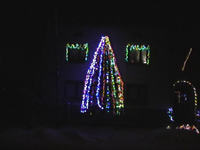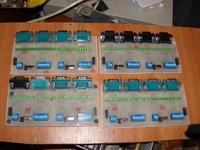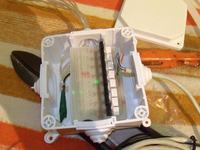Vermes
Advanced Member level 4


It is a project of Christmas lights for every house. First version of the driver supported 80 channels without phase regulation. Then the control electronics were completely converted. A possibility of phase regulation independent of all 128 channels appeared. Now the lights are mostly LEDs ( blue and green on the Christmas tree, all on windows, some small trees near the entrance, white diodes in the gateway). The rest are typical cheapest bulbs. Despite the need for annual repair of all assemblies, after that operation they run smoothly until they are disabled. The most common cause of decay are corroded terminals. Each year about 100 burnt bulbs are changed, but at almost 4000 installed, this is not so much. Although diodes are much more effective, they cause a lot of problems. The lightness regulation isn't as fluent as it is in bulbs. Also, they are able to glow even though the channels is switched off. And of course, they are faulty. What is interesting, the LEDs' structured are rarely damaged. Often the reasons why LEDs don't light are the breaks on one of the resistors. It should be noted that these resistors showed no visual signs of burning/overheating, they simply had breaks. The disadvantage of these lamps hard to eliminate is the fact that the LEDs outputs are now made of steel instead of copper. If moisture, they get corroded.
Control electronics and PC application (which is the biggest possible limitation of the project), are both copyright. The driver consists of modules based on Atmega16 processor. Each module has its own address and supports 16 channels. The driver consists of 8 modules now, but obviously it can be expanded by another, to more than 2000 channels.
The whole was prepared for the three-phase power supply, so for each module, beyond the switches for selecting the address, there are switches for selecting the zero detector attached to the same phase as 16 channels supported by this module. This is required due to the presence of phase regulation. Current consumption of the whole, however, was smaller and now only one phase and one zero detector are used. Implementing modules are traditional optotriac + triac. Those modules are placed in boxes around the house.
Possible modifications of this project are:
- the implementing modules are damaged relatively rarely, so each set could be equipped with its own one-channel of triple channel module for the Christmas tree sets
- modules could be flooded with resin – this considerably would simplified the whole assembly on the Christmas tree
Some photos and video for this installation are below:





Link to original thread – Konkurs - oświetlenie świąteczne domu